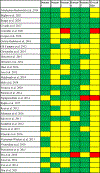Effects of prebiotics, probiotics, and synbiotics on the infant gut microbiota and other health outcomes: A systematic review
- PMID: 37667870
- PMCID: PMC10480560
- DOI: 10.1080/10408398.2021.2022595
Effects of prebiotics, probiotics, and synbiotics on the infant gut microbiota and other health outcomes: A systematic review
Abstract
The primary aim of this review was to systematically evaluate the literature regarding the effect of pre-, pro-, or synbiotic supplementation in infant formula on the gastrointestinal microbiota. The Cochrane methodology for systematic reviews of randomized controlled trials (RCTs) was employed. Five databases were searched and 32 RCTs (2010-2021) were identified for inclusion: 20 prebiotic, 6 probiotic, and 6 synbiotic. The methods utilized to evaluate gastrointestinal microbiota varied across studies and included colony plating, fluorescence in situ hybridization, quantitative real-time polymerase chain reaction, or tagged sequencing of the 16S rRNA gene. Fecal Bifidobacterium levels increased with supplementation of prebiotics and synbiotics but not with probiotics alone. Probiotic and synbiotic supplementation generally increased fecal levels of the bacterial strain supplemented in the formula. Across all pre-, pro-, and synbiotic-supplemented formulas, results were inconsistent regarding fecal Clostridium levels. Fecal pH was lower with some prebiotic and synbiotic supplementation; however, no difference was seen with probiotics. Softer stools were often reported in infants supplemented with pre- and synbiotics, yet results were inconsistent for probiotic-supplemented formula. Limited evidence demonstrates that pre- and synbiotic supplementation increases fecal Bifidobacterium levels. Future studies utilizing comprehensive methodologies and additional studies in probiotics and synbiotics are warranted.
Keywords: Gastrointestinal microbiota; infant; prebiotic; probiotic; synbiotic; systematic review.
Figures



Similar articles
-
Synbiotics of Bifidobacterium breve MCC1274 and lactulose enhances production of tryptophan metabolites in fermented human fecal communities.Food Res Int. 2023 Jan;163:112308. doi: 10.1016/j.foodres.2022.112308. Epub 2022 Dec 9. Food Res Int. 2023. PMID: 36596205
-
Targeting the gut-lung axis by synbiotic feeding to infants in a randomized controlled trial.BMC Biol. 2023 Feb 20;21(1):38. doi: 10.1186/s12915-023-01531-3. BMC Biol. 2023. PMID: 36803508 Free PMC article. Clinical Trial.
-
Prebiotic, Probiotic, and Synbiotic Supplementation in Chronic Kidney Disease: A Systematic Review and Meta-analysis.J Ren Nutr. 2019 May;29(3):209-220. doi: 10.1053/j.jrn.2018.08.008. Epub 2018 Oct 23. J Ren Nutr. 2019. PMID: 30366767
-
Probiotic Bifidobacterium strains and galactooligosaccharides improve intestinal barrier function in obese adults but show no synergism when used together as synbiotics.Microbiome. 2018 Jun 28;6(1):121. doi: 10.1186/s40168-018-0494-4. Microbiome. 2018. PMID: 29954454 Free PMC article. Clinical Trial.
-
Efficacy of probiotic, prebiotic, and synbiotics supplements in individuals with anemia: a systematic review and meta-analysis of randomized controlled trials.BMC Gastroenterol. 2024 Dec 23;24(1):472. doi: 10.1186/s12876-024-03562-8. BMC Gastroenterol. 2024. PMID: 39716076 Free PMC article.
Cited by
-
Pre- to Postbiotics: The Beneficial Roles of Pediatric Dysbiosis Associated with Inflammatory Bowel Diseases.Microorganisms. 2024 Aug 2;12(8):1582. doi: 10.3390/microorganisms12081582. Microorganisms. 2024. PMID: 39203424 Free PMC article. Review.
-
The effect of oral synbiotics on the gut microbiota and inflammatory biomarkers in healthy adults: a systematic review and meta-analysis.Nutr Rev. 2025 Feb 1;83(2):e4-e24. doi: 10.1093/nutrit/nuae002. Nutr Rev. 2025. PMID: 38341803 Free PMC article.
-
Intestinal flora and pregnancy complications: Current insights and future prospects.Imeta. 2024 Jan 22;3(2):e167. doi: 10.1002/imt2.167. eCollection 2024 Apr. Imeta. 2024. PMID: 38882493 Free PMC article. Review.
-
Knowledge, attitude, and practice of Chinese parents with infants (aged 0-3 years) toward immunity, gut microbiota and biotics: a comprehensive study.Front Immunol. 2024 Jul 15;15:1396087. doi: 10.3389/fimmu.2024.1396087. eCollection 2024. Front Immunol. 2024. PMID: 39076968 Free PMC article.
-
A Review of the Influence of Prebiotics, Probiotics, Synbiotics, and Postbiotics on the Human Gut Microbiome and Intestinal Integrity.J Clin Med. 2025 May 23;14(11):3673. doi: 10.3390/jcm14113673. J Clin Med. 2025. PMID: 40507435 Free PMC article. Review.
References
-
- Abrahamse-Berkeveld M, Alles M, Franke-Beckmann E, Helm K, Knecht R, Köllges R, Sandner B, Knol J, Ben Amor K, and Bufe A. 2016. “Infant formula containing galacto-and fructo-oligosaccharides and Bifidobacterium breve M-16V supports adequate growth and tolerance in healthy infants in a randomised, controlled, double-blind, prospective, multicentre study.” J Nutr Sci 5: e42. 10.1017/jns.2016.35. - DOI - PMC - PubMed
-
- American Academy of Pediatrics. Breastfeeding and the Use of Human Milk. March 2012. Accessed November 3, 2021. https://pediatrics.aappublications.org/content/129/3/e827
-
- American Academy of Pediatrics. 2019. Pediatric Nutrition. 8th ed. Itasca, IL: American Academy of Pediatrics.
-
- Béghin L, Tims S, Roelofs M, Rougé C, Oozeer R, Rakza T, Chirico G, Roeselers G, Knol J, Rozé JC, and Turck D. 2021. “Fermented infant formula (with Bifidobacterium breve C50 and Streptococcus thermophilus O65) with prebiotic oligosaccharides is safe and modulates the gut microbiota towards a microbiota closer to that of breastfed infants.” Clin Nutr 40 (3): 778–787. 10.1016/j.clnu.2020.07.024. - DOI - PubMed
Publication types
MeSH terms
Substances
Grants and funding
LinkOut - more resources
Full Text Sources
